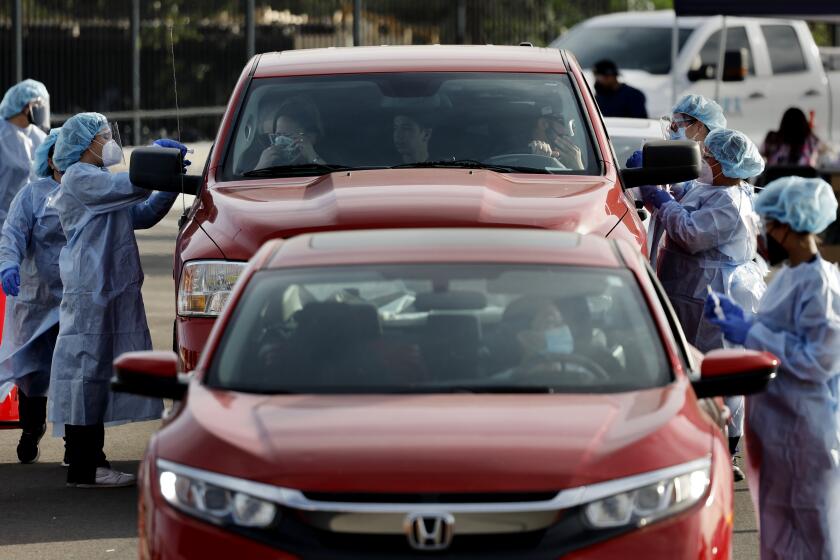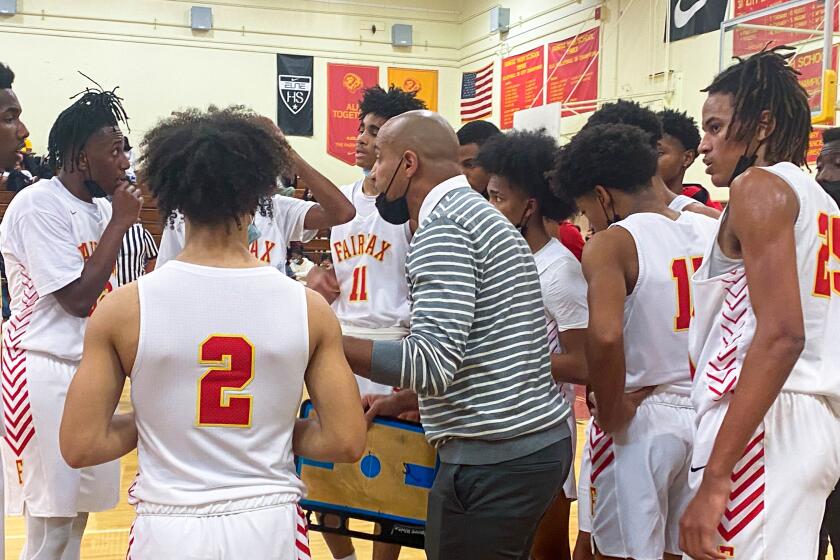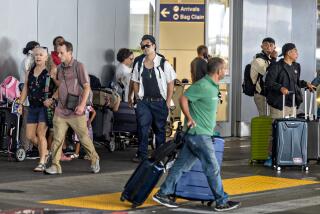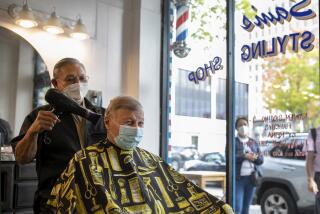Column: Two years of the pandemic, and we’re still not in the clear. But there’s room for optimism

- Share via
When the nation’s second-largest school district reopens for business despite tens of thousands of positive coronavirus tests among students and staff, things have changed.
When the state of California, which led the nation in caution, tells medical staffers who tested positive to go back to work if they’re asymptomatic, things have changed.
When you listen to NPR’s “On Point” podcast and hear doctors saying that in the midst of the Omicron variant surge and hospital fatigue, there are reasons for optimism and that “if you’re vaccinated you can start to live your life again,” things have changed.
We are two years into a pandemic that has killed roughly 5.5 million people globally and altered life in ways big and small. Last January I wrote a column suggesting there was hope for a turnaround because the best medicine available — vaccine — was being pumped into arms everywhere.
So where do we stand now?
I’ve been trying to figure that out and would love to give you a definitive answer. But going forward, the virus will give us new looks and we’ll have to adapt.
Generally speaking, we’re in much better shape than we were two years ago. And better shape than we were a year ago, when getting the vaccine involved a mad scramble to nail down a place in line at a drug store or supermarket.
“I’m very much an optimist,” said Dr. Kimberly Shriner, an infectious disease specialist at Huntington Hospital in Pasadena.
Some parts of the globe that saw Omicron explode are now seeing the wave recede or flatten. California is expected to follow soon.
But don’t take that as an invitation to throw a party and invite everyone you know.
“We have to be very humble in the presence of this virus,” Shriner added.
Humility is not something we saw much of from national leaders in the early days of the pandemic. Even now, after more than 800,000 deaths in the U.S., in many quarters the pandemic is politicized and the science scorned.
And we have know-nothing influencers like Green Bay Packers quarterback Aaron Rodgers and tennis star Novak Djokovic broadcasting the message that no one has any responsibility to anyone else.
It’s shocking that at this point, we have to keep repeating the obvious.
“Those who are vaccinated and boosted are highly protected against severe disease and death,” said Dr. Robert Kim-Farley of the UCLA Fielding School of Public Health.
The vaccine doesn’t prevent infection, just as the flu vaccine doesn’t necessarily keep you from getting the flu. But you’re likely to have an easier time of it.
Another key advance is the rollout of a COVID-19 treatment drug called Paxlovid, which Kim-Farley called a game-changer. Used promptly, he said, “there’s an 88% reduction in hospitalization and death.”
We also now have a rapid antigen test, and “that didn’t exist a year ago,” Kim-Farley said. But we need far more of them to help us know whether we’re contagious to others.
The L.A. Unified School District’s decision to reopen schools led to more than a bit of chaos this week, with 62,000 students and staff out after testing positive. The district reported about 135,000 student absences Tuesday.
But Kim-Farley endorsed the decision to reopen.
“We know that children suffer if they’re not in the classroom, and remote learning, though better than nothing, is not a very good substitute for being in the classroom,” Kim-Farley said. “We also have new tools in our hands for students, including the vaccines we’re now able to give them.”
If schools everywhere can do more weekly testing and can move quickly to improve ventilation and air filtration systems, Kim-Farley said, the risks will be further minimized.
As for the state telling healthcare workers who test positive but are asymptomatic to stay on the job, that’s not a risk-free option. Much like reopening schools, it’s a lesser-of-evils calibration. The Omicron surge and rush to hospitals, by patients who are predominantly unvaccinated, have ravaged front-liners.
“We have some infected staff, but have not gotten to the point where we’re bringing back people who are infected,” said Huntington’s Shriner.
Her hospital is busy at the moment, with roughly 100 COVID-19 patients. If it gets to where patient lives are on the line, Shriner said, coronavirus-positive asymptomatic staffers will be called in.
“If you need their expertise to save a life, you bring them back,” she said.
She added that if “my own loved one” was such a patient, in need of critical care, she’d want the staffer to “mask up, go in there, and save a life.”
Last weekend, I got a personal reminder of how frustrating and scary this time can be for anyone with medical problems, including issues that have nothing to do with COVID-19. My daughter needed attention for a rapidly worsening infection and we had to gauge whether it was riskier to go to the ER in the midst of a COVID-19 surge, or wait a day and try to get in to see her regular doctor.
We went to the ER, where she was treated and released with a prescription. Two nights later, with another scare, we thought about returning to the ER, but a staffer said the hospital was swamped.
Going to the ER should be a last resort, and we didn’t want to burden critically ill patients or staff. But I’m not going to pretend I wasn’t angry on behalf of everyone whose access to care is compromised because the system is overloaded by unvaccinated hordes.
If I let my mind go to the darkest places, I fear that because so much of the world is unvaccinated, we could well see one variant after another circle the globe, and we won’t know whether the next one will be the most lethal yet. I worry too about the continued attack on public health protocols and the vilification of experts.
Kim-Farley called the virus “an outside attack on humanity” and he despairs over the ways in which politicized, “aggressive anti-science” messages have crushed an opportunity for the country and the world to unite against the threat. In a healthier atmosphere, he said, we’d be celebrating the fact that a Republican president moved quickly to develop a vaccine and his Democratic successor moved quickly to make it available to everyone.
When I spoke to Shriner, she had just checked on patients in Huntington’s “long COVID” clinic.
“Our youngest patient is 26, the oldest are in their 70s,” she said, and long COVID — also known as post-acute sequelae of COVID — has been seen in children as well. Her patients have blood clots, inflammation of the brain, heart and lungs. Some have brain fog, some have gotten better and returned to work, some have not.
All the more reason to vaccinate, mask and distance, and to enjoy the freedoms that come with those precautions.
I asked Shriner how often she is asked by friends, family or colleagues for advice on do’s and don’ts. Every day, she said, and she tells people to pretend they have 10 risk cards.
“You have to decide whether you want to use one of those cards,” she said when I asked if I should eat in the parking lot tent of a restaurant near her hospital.
After being sidelined for a week because of the Omicron variant, Los Angeles Unified School District athletes hope to return to action soon.
I told her I can’t believe how many times I’ve watched a ballgame on TV and noticed that most spectators aren’t masked. Even at an outdoor game, is that safe?
“If you want to attend a football or baseball game, you have to ask if that’s where you want to spend a risk card,” Shriner said. “Travel right now is very dangerous, but some people have to do it. If you have a loved one who’s in a bad way, you may have to use a card for that.”
If she’s outdoors walking her dog, Shriner told me, she drops her mask. But if someone comes close, she pulls it back up.
“I don’t come from the ‘everybody’s going to get it school.’ I don’t want to get it. It doesn’t look like fun,” Shriner said. “I’m not going to be locked up, but I’m going to be sensible. … I think we can be hopeful because we’ve conquered all kinds of obstacles in the past. This is just going to take time, patience, equity and selflessness.”
So maybe you can breathe a little easier than you could at the start of 2020 or 2021.
But don’t let your guard down yet.
More to Read
Sign up for Essential California
The most important California stories and recommendations in your inbox every morning.
You may occasionally receive promotional content from the Los Angeles Times.













